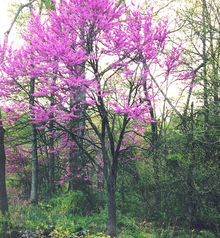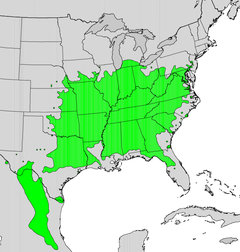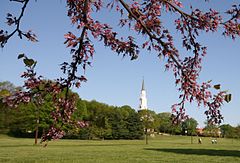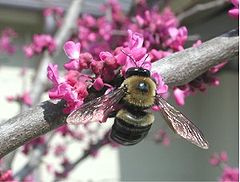- Cercis canadensis
-
Eastern Red bud 
Eastern Redbud (Cercis canadensis) in Gettysburg National Military Park. Conservation status Scientific classification Kingdom: Plantae (unranked): Angiosperms (unranked): Eudicots (unranked): Rosids Order: Fabales Family: Fabaceae Genus: Cercis Species: C. canadensis Binomial name Cercis canadensis
L.
natural range Cercis canadensis L. (Eastern Redbud) is a large shrub or small tree native to eastern North America from Southern Ontario, Canada south to northern Florida, United States.
University of Maryland Arboretum & Botanical Garden with the Memorial Chapel (University of Maryland) in the background
It typically grows to 6–9 m (20–30 feet) tall with a 8–10 m (25–35 foot) spread. It generally has a short, often twisted trunk and spreading branches. A 10-year-old tree will generally be around 5 m (15 ft) tall. The bark is dark in color, smooth, later scaly with ridges somewhat apparent, sometimes with maroon patches. The twigs are slender and zigzag, nearly black in color, spotted with lighter lenticels. The winter buds are tiny, rounded and dark red to chestnut in color. The leaves are alternate, simple, heart shaped with an entire margin, 7–12 cm (3-5 inches) long and wide, thin and papery, and may be slightly hairy below.
The flowers are showy, light to dark magenta pink in color, 1.5 cm (½ inch) long, appearing in clusters from March to May, on bare stems before the leaves, sometimes on the trunk itself. The flowers are pollinated by long-tongued bees such as blueberry bees and carpenter bees. Short-tongued bees apparently cannot reach the nectaries. The fruit are flattened, dry, brown, pea-like pods, 5–10 cm (2-4 inches) long that contain flat, elliptical, brown seeds 6 mm (¼ inch) long, maturing in August to October.
Carpenter bee (Xylocopa virginica) on redbud flowers.
In some parts of southern Appalachia, green twigs from the Eastern redbud are used as seasoning for wild game such as venison and opossum. Because of this, in these mountain areas the Eastern redbud is sometimes known as the spicewood tree.
In the wild, Eastern redbud is a frequent native understory tree in mixed forests and hedgerows. It is also much planted as a landscape ornamental plant. The leaves are eaten by the caterpillars of some Lepidoptera, for example the Io moth (Automeris io).
The redbud is the state tree of Oklahoma.
Contents
Description
A small tree with a sturdy upright trunk which divides into stout branches that usually spread to form a broad flat head. Found on rich bottom lands throughout the Mississippi River valley; will grow in the shade and often becomes a dense undergrowth in the forest. Very abundant in Arkansas, Oklahoma, and eastern Texas. Hardy far north; grows rapidly; is a satisfactory ornamental tree. Many trees are sterile and produce no fruit. It is also known as the Judas tree.
This tree is difficult to grow as far west as western Kansas and Colorado, as there is not sufficient water. Its far northern range of growth is southern New England. It grows well in New York State, New Jersey and southward.
- Bark: Red brown, with deep fissures and scaly surface. Branchlets at first lustrous brown, later become darker.
- Wood: Dark reddish brown; heavy, hard, coarse-grained, not strong. Sp. gr., 0.6363; weight of cu. ft. 39.65 lbs.
- Winter buds: Chestnut brown, obtuse, one-eighth inch long.
- Leaves: Alternate, simple, heart-shaped or broadly ovate, two to five inches long, five to seven-nerved, chordate or truncate at the base, entire, acute. They come out of the bud folded along the line of the midrib, tawny green; when they are full grown they become smooth, dark green above, paler beneath. In autumn they turn bright clear yellow. Petioles slender, terete, enlarged at the base. Stipules caduceous.
- Flowers: April, May, before and with the leaves, papilionaceous. Perfect, rose color, borne four to eight together, in fascicles which appear at the axils of the leaves or along the branch and sometimes on the trunk itself.
- Calyx: Dark red, campanulate, oblique, five-toothed, imbricate in bud.
- Corolla: Papilionaceous, petals five, nearly equal, pink or rose color, upper petal the smallest, enclosed in the bud by the wings, and encircled by the broader keel petals.
- Stamens: Ten, inserted in two rows on a thin disk, free, the inner row rather shorter than the others.
- Pistil: Ovary superior, inserted obliquely in the bottom of the calyx tube, stipitate; style fleshy, incurved, tipped with an obtuse stigma.
- Fruit: Legume, slightly stipitate, unequally oblong, acute at each end. Compressed, tipped with the remnants of the style, straight on upper and curved on the lower edge. Two and a half to three inches long, rose color, full grown by midsummer, falls in early winter. Seeds ten to twelve, chestnut brown, one-fourth of an inch long -can be made to germinate by first dipping in boiled (99C) water (very hot) for a minute and then sowing in a pot (do not boil the seeds); cotyledons oval, flat.[2]
Edibility
Native Americans consumed redbud flowers raw or boiled, and ate roasted seeds. Analysis of nutritional components in edible parts of eastern redbud reported that:
- the flower extract contains anthocyanins,
- green developing seeds contained proanthocyanides, and
- linolenic, alpha-linolenic, oleic and palmitic acids to be present in seeds.[3]
See also
References
- ^ Hilton-Taylor (2000). Cercis canadensis. 2006. IUCN Red List of Threatened Species. IUCN 2006. www.iucnredlist.org. Retrieved on 5 May 2006.
- ^ Keeler, Harriet L. (1900). Our Native Trees and How to Identify Them. New York: Charles Scriber's Sons. pp. 104–108.
- ^ Laura J. Hunter, et al. 2006. Analysis of nutritional components in edible parts of eastern redbud (Cercis canadensis L.). 62nd Southwest Regional American Chemical Society Meeting, Houston, Texas.
External links
- Cercis canadensis Large format diagnostic photographs and information. Morton Arboretum acc. 380-88-6
- Cercis canadensis images at bioimages.vanderbilt.edu
- NCRS: USDA Plants Profile: Cercis canadensis
Categories:- IUCN Red List least concern species
- Cercis
- Trees of the United States
- Trees of Canada
- Trees of Appalachia U.S.
- Trees of the Eastern United States
- Trees of the Plains-Midwest (United States)
- Trees of New Mexico
- Trees of Ontario
- Trees of Oklahoma
- Trees of Northeastern Mexico
- Trees of Colima
- Trees of Hidalgo
- Trees of Nuevo León
- Trees of San Luis Potosí
- Trees of Tamaulipas
- Trees of Alabama
- Trees of North Carolina
- Trees of Michigan
- Trees of humid continental climate
- Ornamental trees
- Garden plants of North America
- Least concern plants
Wikimedia Foundation. 2010.






